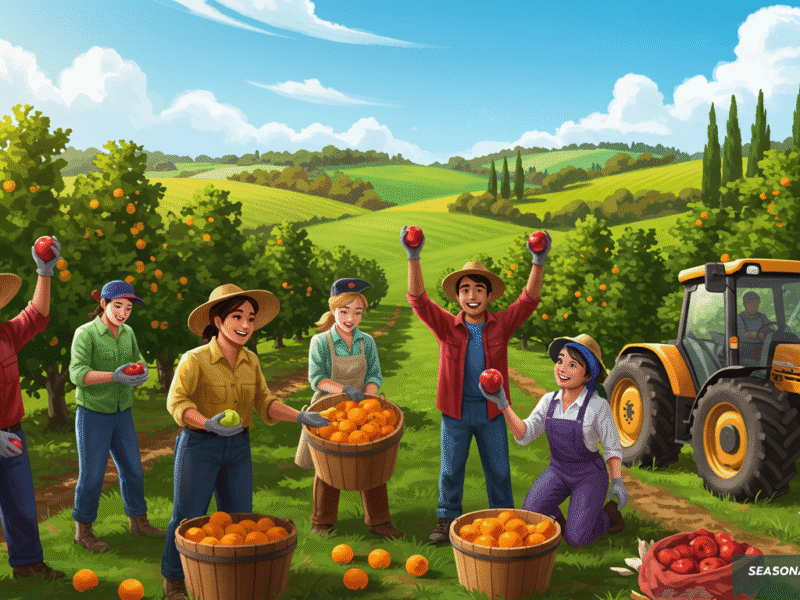Imagine stepping into the vast, sun-kissed fields of America, where the air smells of fresh earth and ripe fruit, and every harvest tells a story of hard work turning into opportunity—that’s the allure of agriculture and fruit picking jobs in the USA with visa sponsorship.
These roles aren’t just about labor; they’re a gateway for people from around the world to experience life in one of the most productive farming nations on the planet. If you’re dreaming of working on American farms, picking apples in Washington or oranges in Florida, while getting your visa sponsored, you’re in the right place. The USA’s agriculture industry is massive, producing everything from berries to grains, and it relies heavily on seasonal workers to keep things running smoothly. But with labor shortages hitting hard, employers are turning to programs like the H-2A visa to bring in international talent. In this guide, we’ll dive deep into what these jobs entail, how to land one with visa sponsorship, the best places to look, and everything else you need to know to make it happen. Whether you’re a first-timer or have some farm experience under your belt, let’s break it down step by step.
Understanding the Jobs
What Agriculture and Fruit Picking Jobs Entail
First off, let’s talk about what agriculture and fruit picking jobs in the USA really look like. Fruit picking is one of the most common entry points—think climbing ladders to harvest cherries, bending down for strawberries, or gathering grapes in vineyards. These are seasonal gigs, often lasting from a few weeks to several months, depending on the crop. For instance, strawberry season might kick off in spring in California, while apple picking ramps up in fall in states like New York or Michigan. Beyond fruit, agriculture jobs cover a wide range: operating farm machinery, planting seeds, tending to livestock, or even packing produce in warehouses. Many of these positions require physical stamina because you’re out in the elements—rain or shine—lifting heavy crates or walking miles through fields. But don’t worry if you’re not a pro yet; a lot of employers provide on-the-job training, especially for visa-sponsored roles where they’re eager to fill spots.
Diving Deeper into Types of Fruit Picking Jobs
Diving deeper into types of fruit picking jobs, strawberries are entry-level—quick to learn, but low to the ground, so knee pads help. Apple picking involves ladders and bags, paying by the bushel in places like New York’s Hudson Valley. Citrus in Florida means dealing with thorns but higher volumes. Beyond picking, packing jobs in warehouses are less physical, sorting fruit for shipment. Livestock roles, like herding sheep in Idaho, offer variety. Each has seasons: berries June-August, citrus winter spring. Pay structures vary—hourly or piece-rate (per box picked), incentivizing speed.
Demand and Visa Sponsorship
The demand for these jobs is huge because American farms face chronic labor shortages. According to reports from the U.S. Department of Labor, millions of acres of crops go unharvested each year due to a lack of workers. That’s where visa sponsorship comes in, making it possible for foreigners to step up and help. The H-2A temporary agricultural worker program is the star here—it’s designed specifically for seasonal farm work when there aren’t enough U.S. workers available. Employers sponsor your visa, meaning they handle a big chunk of the paperwork to bring you over legally. This isn’t a path to permanent residency, but it’s a solid way to earn good money, gain experience, and see a different side of America. Wages are regulated too, often starting around $15 to $20 per hour or more, depending on the state and job type. Plus, many gigs include perks like free housing and transportation, which can make a big difference when you’re starting out.
Why Choose These Jobs
Now, why choose agriculture jobs in the USA with visa sponsorship? For starters, it’s an adventure. Picture yourself in California’s Central Valley, surrounded by endless rows of almond trees, or in Florida’s citrus groves where the oranges glow under the sun. These jobs offer a chance to travel, learn new skills, and build a resume that stands out. Financially, it’s appealing—many workers save up thousands during a season to support families back home. And culturally, it’s enriching; you’ll meet people from all over, like fellow pickers from Mexico, Jamaica, or South Africa, sharing stories around a campfire after a long day. But it’s not all romantic—farm work is tough, with early mornings and sore muscles. Still, for those willing to roll up their sleeves, it’s rewarding. The industry is evolving too, with tech like drones for crop monitoring or automated harvesters, so there’s room to grow into more skilled roles over time.
Visa Details and Requirements
The H-2A Visa Explained
Let’s zoom in on the visa side of things, because that’s the key to making this dream real. The H-2A visa is your ticket for temporary agricultural jobs in the USA. It’s open to people from many countries, and as of recent updates, there’s no longer a restriction based on your nationality—anyone can apply as long as the employer sponsors you. To qualify, the job must be seasonal or temporary, usually lasting up to 10 months, and the employer has to prove they couldn’t find enough American workers. Employers file the paperwork, starting with a temporary labor certification from the Department of Labor, then a petition with USCIS. Once approved, you apply for the visa at a U.S. embassy in your home country. The whole process can take 60 to 75 days, so planning ahead is crucial. Recent changes, like those effective from January 2025, emphasize worker protections—no hidden fees from recruiters, and stricter rules against exploitation. If an employer breaks these, they could face denials on future petitions.
Employer Requirements and Worker Protections
Employer requirements are strict to protect everyone involved. They must pay at least the adverse effect wage rate, which varies by state—for example, around $17 in California or $15 in Florida—to ensure it doesn’t undercut local pay. Housing has to be safe and free if you’re staying overnight, and transportation to the job site is covered. Workers get guarantees too: at least 75% of the contract hours must be offered, and you can’t be charged prohibited fees like recruitment costs. If something goes wrong, like you don’t show up or quit early, the employer has to notify USCIS quickly. These rules make the program fairer, but it’s worth knowing your rights—things like no retaliation for complaints and access to health care if needed.
Finding and Qualifying for Jobs
Where to Find Jobs
Finding agriculture jobs in the USA with visa sponsorship isn’t as hard as it sounds if you know where to look. Start with official sites like the Department of Labor’s Seasonal Jobs portal, where employers post H-2A openings nationwide. It’s a goldmine for fruit picking gigs in states like Washington for apples or Michigan for blueberries. Other top job sites include Indeed, where you can search “visa sponsorship fruit picking USA,” or ZipRecruiter for farming visa sponsorship roles. Specialized platforms like USA Farm Labor connect employers with international workers, handling the H-2A process. LinkedIn is great too—follow pages for farms like Sakuma Brothers in Washington or Gebbers Farms in California, which often hire via H-2A. Social media, like Facebook groups for farm jobs in the United States, buzz with listings and tips from current workers. And don’t overlook Reddit threads in subreddits like r/Agriculture for real-talk advice on seasonal work with visas.
Best States and Seasons
The best states for these jobs depend on what you’re picking and when. California tops the list—it’s the king of produce, with strawberry picking in spring around Oxnard or grape harvesting in fall in Napa Valley. Wages here are solid, often over $18 per hour, and the mild weather makes it bearable. Florida is huge for citrus; orange picking seasons run from October to June, with employers like Citrus Bay Orchards using H-2A workers. Washington’s orchards explode with apples and cherries in summer and fall—places like Cherry Bay Orchards sponsor visas for hundreds of pickers. Other hotspots include Michigan for berries, Oregon for pears, and Texas for veggies. Seasons vary: spring for strawberries in the South, summer for berries up North, fall for apples everywhere. Research the crop calendar for your target state to time your applications right.
Exploring states more: Washington’s Yakima Valley is cherry heaven, with peaks in July. Employers like Stennes Family Farms share workers via H-2A. Florida’s Immokalee area buzzes with tomatoes and oranges—hot but high demand. California’s Salinas Valley, “America’s Salad Bowl,” has lettuce and strawberries year-round-ish. Michigan’s Traverse City for cherries in summer—scenic but short season. Oregon’s Hood River for pears and apples in fall. Texas Panhandle for cotton or melons. Each state has unique vibes: California’s diverse, Florida’s humid, Washington’s mountainous.
Qualifications Needed
What do you need to qualify for fruit picking jobs in the USA with visa sponsorship? Physically, it’s demanding—you’ll be on your feet for 8-12 hours, lifting 50-pound boxes, and dealing with heat or bugs. No formal education is required, but basic English helps for safety instructions. Experience isn’t always necessary; many farms train you, but if you’ve picked fruit back home, highlight it. For H-2A, you must be at least 18, pass a background check, and not have certain criminal records. Health-wise, be ready for a medical exam during the visa process. Skills like operating tractors can lead to better-paying roles, around $20+ per hour. And remember, these are temporary—after your contract, you head home, but you can reapply for future seasons.
Requirements expanded: No degree needed, but certifications like pesticide handling boost chances for better jobs. Physical tests aren’t formal, but expect to prove you can lift 50 lbs. Age: 18+, no upper limit if fit. Background: Clean record, especially no drug offenses. For women, opportunities are equal, though some jobs skew male. Language: Basic English for safety; many farms have bilingual supervisors.
Benefits and Challenges
Benefits of These Jobs
The benefits of these jobs go beyond the paycheck. Wages are protected—expect $15-25 hourly, plus overtime if over 40 hours. Many earn $10,000-20,000 in a season after expenses. Housing is often provided, like dorms or trailers on the farm, saving you rent. Transportation from your home country might be reimbursed, and meals could be covered. Culturally, it’s eye-opening—learning about American farming tech or making lifelong friends. Some workers use it as a stepping stone, gaining skills for future visas or jobs elsewhere. Plus, you’re contributing to feeding the nation; it’s fulfilling knowing your hands helped put food on tables.
Benefits in detail: Wages—adverse effect rate ensures fairness, like $17.34 in Minnesota. Overtime at 1.5x after 40 hours. Housing: Inspected for safety, often shared rooms. Transportation: Inbound/outbound covered if you complete the contract. Meals: Sometimes provided or subsidized. Experience: Learn sustainable farming, perhaps organic methods. Networking: Connect for future gigs.
Challenges to Consider
But let’s be real—there are challenges in farm work for foreigners in the USA. The physical toll is big; backaches and sunburns are common, and injuries happen if you’re not careful. Isolation is another—farms are rural, so limited entertainment or family time. Language barriers can frustrate, especially if supervisors speak only English. Exploitation risks exist, though H-2A rules fight it with protections against low pay or bad housing. Weather unpredictability means days off without warning, affecting earnings. And the seasonal nature means uncertainty—will you get sponsored next year? Health care access varies; while employers must provide workers’ comp, it’s not always comprehensive. Still, many overcome these by joining worker support groups or unions like Farmworker Justice.
Challenges elaborated: Heat exhaustion in summer—stay hydrated. Loneliness—bring books or join local events. Rights issues: Know you can report abuses anonymously via DOL hotlines. Economic: Piece-rate pay fluctuates with yield. Cultural shock: American work pace is fast. But positives outweigh for many.
Applying and Succeeding
How to Apply
How do you apply for agriculture jobs in the USA with visa sponsorship? Start by building a simple resume: list any farm experience, physical fitness, and why you’re eager. Search job sites for “H-2A fruit picking jobs” and apply directly—include your availability and willingness to relocate. If an employer bites, they’ll guide the sponsorship. They’ll file for labor certification, proving no local hires, then the I-129 petition. You’ll need a passport, photos, and forms for your visa interview. Costs: you pay visa fees (around $190), but employers cover most. Tips: apply early, like 3-4 months before season start, and avoid shady recruiters charging fees—that’s illegal under H-2A. Track your application via USCIS online.
Application deep dive: Resume tips—keep it one page, emphasize reliability. Interviews: Often virtual, stress teamwork. Visa docs: DS-160 form, proof of ties home (to show you’ll return). Embassy tips: Dress neat, answer honestly. Post-arrival: Get Social Security number for pay, open a bank account.
Success Stories and Tips
Success stories abound to inspire you. Take workers from Jamaica picking berries in Michigan—they save enough in one season to build homes back home. Or Mexicans in California’s vineyards, returning year after year, even bringing family on H-4 visas (though they can’t work). One guy I heard about started as a picker and learned machinery, boosting his pay. Challenges? Sure, like adapting to cold winters in the North, but the community helps. Prep by exercising, learning basic farm terms, and packing essentials like sturdy boots.
Tips for success: Pack layers for weather changes, work gloves, sunscreen. Budget: Save 50% of earnings. Health: Get travel insurance. Community: Join online forums for H-2A workers.
Conclusion
In wrapping up, agriculture and fruit picking jobs in the USA with visa sponsorship offer a unique blend of hard work, adventure, and reward. If you’re ready to harvest opportunities, start searching today. It’s not easy, but the stories you’ll tell—and the money you’ll make—make it worthwhile.
Additional Resources
For more info, check these resources:











